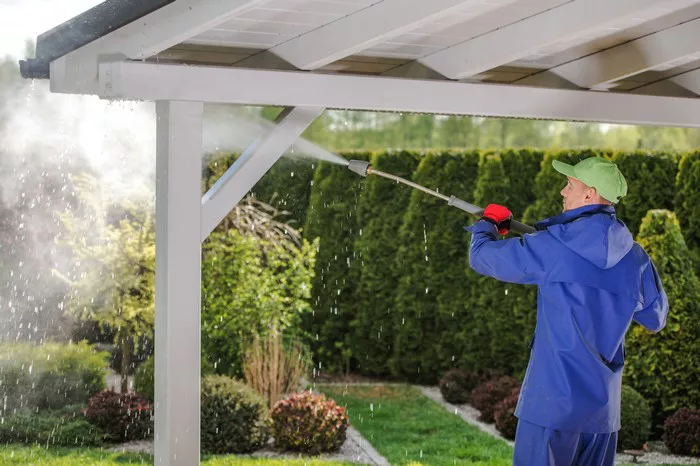Power washing and pressure washing are two common methods used for cleaning various surfaces, from driveways to decks. While they may seem similar, there are key differences between the two techniques that can impact their effectiveness and suitability for different cleaning tasks. Understanding these distinctions is crucial for selecting the most appropriate cleaning approach for your needs.
Pressure Washing Overview
Definition
Pressure washing involves the use of high-pressure water spray to remove dirt, grime, mold, and other debris from surfaces. It is a versatile cleaning method that can be used for a wide range of applications, from cleaning driveways and sidewalks to preparing surfaces for painting or sealing.
Equipment
A typical pressure washer consists of several components, including a pump, engine or motor, hose, wand, and nozzle. The pump pressurizes water from a garden hose, which is then expelled through a nozzle at high pressure to create a concentrated stream of water.
Typical Applications
Pressure washing is commonly used for routine cleaning tasks where the primary goal is to remove surface dirt, dust, and debris. It is effective for cleaning outdoor surfaces such as driveways, sidewalks, decks, and siding, as well as for prepping surfaces for painting or staining.
Power Washing Overview
Definition
Power washing is a cleaning method similar to pressure washing but with one key difference: the use of hot water in addition to high-pressure water spray. The inclusion of hot water in power washing can enhance cleaning effectiveness, particularly for removing tough stains, grease, and oil.
Equipment
Power washers are similar to pressure washers in terms of their components but include a heating element to heat the water before spraying it onto surfaces. This heated water can reach temperatures ranging from 180°F to 200°F, depending on the model.
Advantages of Hot Water
The use of hot water in power washing offers several advantages over cold water pressure washing:
1. Enhanced Cleaning Power: Hot water can dissolve grease and oil more effectively than cold water, making it ideal for cleaning surfaces with heavy oil or grease buildup.
2. Improved Stain Removal: The heat helps to break down stubborn stains, such as mildew, mold, and algae, allowing for more thorough cleaning results.
3. Sanitization: Hot water can also sanitize surfaces by killing bacteria and other pathogens, making it a preferred choice for cleaning applications where sanitation is important.
Key Differences
Temperature
The primary difference between power washing and pressure washing is the use of hot water in power washing and cold water in pressure washing. The addition of heat in power washing can significantly enhance cleaning effectiveness, particularly for removing grease, oil, and tough stains.
Cleaning Efficiency
Due to the inclusion of hot water, power washing is generally more efficient at removing grease, oil, and stubborn stains compared to pressure washing with cold water alone. Power washing is often preferred for tougher cleaning tasks or heavily soiled surfaces.
Versatility
While power washing is effective for cleaning heavily soiled surfaces and removing grease or oil stains, pressure washing with cold water may be sufficient for routine maintenance cleaning or preparing surfaces for painting or sealing. Pressure washing is also suitable for cleaning delicate surfaces that may be sensitive to heat.
Suitable Applications
Power Washing
Power washing is preferred for:
1. Cleaning heavily soiled surfaces, such as garage floors or industrial equipment.
2. Removing grease or oil stains from driveways, parking lots, or restaurant kitchens.
3. Sanitizing surfaces, such as outdoor furniture or playground equipment.
Pressure Washing
Pressure washing is suitable for:
1. Routine cleaning of outdoor surfaces, including sidewalks, decks, and siding.
2. Removing dirt, dust, and debris from surfaces before painting or sealing.
3. Cleaning delicate surfaces, such as wood or vinyl, that may be sensitive to heat.
Safety Considerations
High-Pressure Risks
Both power washing and pressure washing involve the use of high-pressure water, which can pose risks if not used properly. Users should be cautious to avoid injury or surface damage and follow safety guidelines provided by the manufacturer.
Hot Water Precautions
When using hot water in power washing, it’s essential to exercise caution and avoid using excessive heat on delicate surfaces or materials that may be sensitive to heat. Always test a small area first to ensure compatibility with hot water cleaning.
Cost and Equipment
Cost Comparison
In terms of equipment costs, power washers are generally more expensive than pressure washers due to the additional heating element. Operating expenses, such as fuel or electricity, may also be higher for power washing due to the energy required to heat the water.
Equipment Availability
Both power washers and pressure washers are available for purchase or rental, depending on the user’s needs and budget. Rental options are often more cost-effective for occasional use, while purchasing may be more economical for frequent or commercial use.
Environmental Impact
Chemical Usage
The environmental impact of power washing and pressure washing depends largely on the use of detergents and chemicals. Users should be mindful of the types of cleaning agents they use and opt for eco-friendly options whenever possible to minimize harm to the environment.
Water Usage
Both power washing and pressure washing can consume significant amounts of water, so users should practice water conservation whenever possible. This includes using water-efficient equipment, such as low-flow nozzles, and avoiding wasteful practices, such as prolonged spraying or unnecessary runoff.
Conclusion
In summary, the primary difference between power washing and pressure washing lies in the use of hot water in power washing and cold water in pressure washing. Power washing offers enhanced cleaning power and is preferred for tougher cleaning tasks or heavily soiled surfaces, while pressure washing is suitable for routine maintenance cleaning or preparing surfaces for painting or sealing. By understanding these distinctions and considering factors such as surface type, level of soiling, and environmental impact, users can choose the most appropriate cleaning method for their needs. Remember to prioritize safety, use eco-friendly cleaning solutions, and follow manufacturer guidelines for optimal cleaning results.

